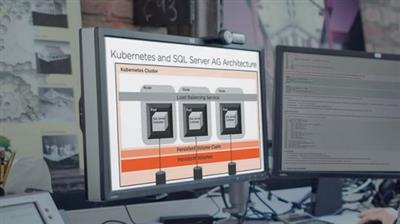Udemy - Linux High Availability Clustering by Shikhar Verma
"softddl.org"
14-04-2021, 01:27
-
Share on social networks:
-
Download for free: Udemy -
-

MP4 | Video: h264, 1280x720 | Audio: AAC, 44.1 KHz, 2 Ch
Genre: eLearning | Language: English | Duration: 56 lectures (6h 52m) | Size: 2 GB
Design and deploy a high availability cluster to provide active/passive or active/active services using HA Pacemaker

MP4 | Video: h264, 1280x720 | Audio: AAC, 44.1 KHz, 2 Ch
Genre: eLearning | Language: English | Duration: 56 lectures (6h 52m) | Size: 2 GB
Design and deploy a high availability cluster to provide active/passive or active/active services using HA Pacemaker
What you'll learn:
Students should understand HA cluster concepts and how to manage different nodes, start/stop services
Creating High-Availability Clusters
Managing Cluster Nodes and Quorum
Managing Fencing
Creating and Configuring Resources
Managing Constraints
About Order, Location & Colocation Constraints
Troubleshooting High-Availability Clusters
Controlling Complex Resource groups
Managing Two Node Clusters
Concept about Split Brain, Fence death/fence racing
Managing iSCSI Initiators
Configuring & Managing High-Availability Logical Volumes
Managing Clustered Logical Volumes
GFS2 Concepts
Creating a GFS2 formatted Cluster File Systems
Growing & Repairing a GFS2 File System
Requirements
PC or Laptop with internet Connection
Red Hat Certified Engineer (RHCE) certification or equivalent experience.
CentOS 7, RHEL7 ISO Image
Vmware workstation
Description
This course helps you to understand high availability clustering by providing a strong concept and hands-on experience with Pacemaker and Corosync components of Red Hat / CentOS Enterprise High Availability Cluster.
Lab Design : KVM based lab setup in this course module.
Subtitle is not added in this course module.
Course Content:
Introduction
What is clustering & cluster types?
Advantages of Clustering Servers
Concepts and techniques
Resource and resource groups
Failover, Fencing, Shared Storage, Quorum
Cluster Architecture
Lab Setup using KVM Environment
Configuring a Basic Cluster
Configuring a fencing agent using KVM host mahcine
Troubleshooting fencing device
Managing Cluster Nodes
Starting & Stopping Cluster Services
Enabling & Disabling the Cluster Services
Adding & Removing A Cluster Node
The Standby & unstandby Nodes
Quorum Operations
Lab Session on quorum
Managing Quorum Calculations
Cluster Setup Switches
1) wait_for_all
2) auto_tie_breaker
Creating and Configuring Resources
Create and configure high-availability resources.
Creating a clustered Apache service
Managing Resources
Troubleshooting High-Availability Cluster
Inspect and configure cluster logging
Troubleshooting resource failures
Troubleshooting cluster network issues
Complex Resource Group
Configuring an Active/Passive NFS Resource Group
Lab Session
Managing Constraints
Types of constraints:
Order, Location & Colocation Constraint
Practice Lab Session
Two Node Cluster Issues
No room for node failure
Split Brain
Fence death/fence racing
The cluster does not start until both nodes have started.
Practice Lab Session
Managing iSCSI Initiators
iSCSI fundamentals
Configuring an iSCSI Server
Several types of backing Storage
block, fileio, pscsi & ramdisk
Creating iSCSI Target
Lab Session to create a block backstore from the targetcli shell
Managing High Availability Logical Volumes
Clustered LVM & HA-LVM
Lab Session to shared a disk (lun) to all cluster nodes
Practice Lab Session on HA-LVM
Managing Clustered Logical Volumes
Active/Active configuration of logical volumes
Distributed Lock Manager (DLM) for lock management
clvmd daemon
Practice Lab Session
Global File System 2 (GFS2)
GFS2 concepts
Creating a GFS2 formatted Cluster File Systems
Managing a GFS2 File System
Managing a GFS2 Resource in the cluster
Growing & Repairing a GFS2 File System
Who this course is for
Linux High Availability Clustering course is aimed at senior system administrators responsible for maximizing resiliency though high availability clustering services
Homepage
https://www.udemy.com/course/linux-high-availability-cluster/
Buy Premium From My Links To Get Resumable Support,Max Speed & Support Me

https://uploadgig.com/file/download/aE99e0b3fee7C204/e32q5.Linux.High.Availability.Clustering.by.Shikhar.Verma.part1.rar
https://uploadgig.com/file/download/33d7c19f3fC4A837/e32q5.Linux.High.Availability.Clustering.by.Shikhar.Verma.part2.rar
https://uploadgig.com/file/download/8cAEe04550a8a28C/e32q5.Linux.High.Availability.Clustering.by.Shikhar.Verma.part3.rar

https://rapidgator.net/file/7b2a6bdae590777b5b6af3cb948b5058/e32q5.Linux.High.Availability.Clustering.by.Shikhar.Verma.part1.rar.html
https://rapidgator.net/file/c8f7cfe9a5d19fa99fc77334354d90a4/e32q5.Linux.High.Availability.Clustering.by.Shikhar.Verma.part2.rar.html
https://rapidgator.net/file/46a6cf688fe0a1470c0a104ef4d4b62b/e32q5.Linux.High.Availability.Clustering.by.Shikhar.Verma.part3.rar.html

http://nitroflare.com/view/BED2B37BBC4D2D6/e32q5.Linux.High.Availability.Clustering.by.Shikhar.Verma.part1.rar
http://nitroflare.com/view/711C1701F36F6F1/e32q5.Linux.High.Availability.Clustering.by.Shikhar.Verma.part2.rar
http://nitroflare.com/view/C13F64C0C7DC219/e32q5.Linux.High.Availability.Clustering.by.Shikhar.Verma.part3.rar
Links are Interchangeable - No Password - Single Extraction
The minimum comment length is 50 characters. comments are moderated
![[2020] Linux Web server High-Availability cluster](https://i112.fastpic.ru/big/2020/0630/73/60311c4a95a08c00ac07e68a42ed4d73.jpeg)



